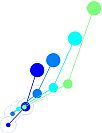Network creation games serve as valuable models for understanding the decentralized formation of economic and social networks, where self-interested agents aim to balance maximizing their connectivity while minimizing the number of links they maintain. Traditional models often simplistically assume that agents have complete visibility of the entire network or/and act synchronously, assumptions that are particularly unrealistic in real-world interactions. To address this limitation, our study embraces those constraints and proposes an Agent-Based computational model where individuals act asynchronously based on a partial view of the network. Despite these constraints, our model consistently converges towards the most efficient network structure. While a revised best response model achieves comparable structural results, it fails to replicate the temporal dynamics observed in a past empirical study, such as the frequency of actions. Our approach addresses this by assigning a utility to the action of 'inaction' dependent on the current network state, and by including an exploration bias. Our model's ability to capture complex network dynamics from past experiments suggests that seemingly complex behaviors in such games can emerge from decentralized, homogenous, payoff-driven agents.
Recherche par auteur > Dahmou HichamAgent-Based Modeling of Asynchronous Network Formation Games
1 : Institut des sciences cognitives Marc Jeannerod - Centre de neuroscience cognitive - UMR5229
Centre National de la Recherche Scientifique
2 : Université Claude Bernard Lyon 1 - Faculté des sciences
Universé Lyon 1
3 : Université de Lille: Faculté des Sciences Juridiques, Politiques et Sociales
Faculté des Sciences Juridiques, Politiques et Sociales
4 : Groupe d'Analyse et de Théorie Economique Lyon - Saint-Etienne
CNRS, GATE L-SE UMR 5824, F-69342 Lyon, France
|

 PDF version
PDF version
